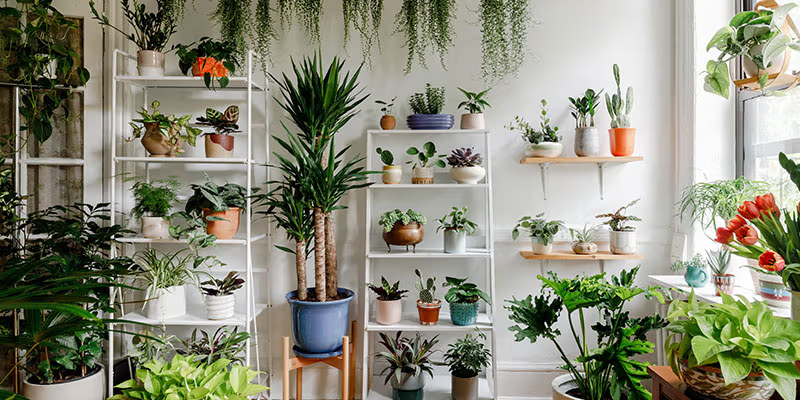
Bringing plants into your home is one of the best ways to add life, color, and a sense of tranquility to any room. Not only do plants help purify the air, but they can also boost your mood, increase productivity, and reduce stress. However, when it comes to choosing the right plants for your indoor space, it can be a bit overwhelming with so many options available.
In this guide, we’ll explore different types of houseplants, from low-maintenance varieties to more vibrant, tropical options. Whether you’re an experienced plant parent or just starting your plant journey, there’s a perfect plant for every home. Let’s dive into the top types of plants to keep in your house.
- Low-Maintenance Indoor Plants
If you’re new to caring for plants or simply don’t have a lot of time to dedicate to plant care, low-maintenance plants are a great choice. These plants are hardy, adaptable, and can thrive even with minimal attention.
a) Snake Plant (Sansevieria)
- Care: Snake plants are nearly indestructible. They can tolerate low light, require little watering, and can survive for weeks without attention.
- Why it’s great: Known for its air-purifying qualities, the snake plant is ideal for bedrooms, living rooms, or offices. Its upright, sword-like leaves add a sleek, modern touch to any space.
- b) ZZ Plant (Zamioculcas zamiifolia)1
- Care: ZZ plants thrive in low to bright indirect light and don’t need frequent watering. They can tolerate dry soil, making them perfect for those with a busy lifestyle.
- Why it’s great: With its waxy, dark green leaves, the ZZ plant adds a touch of elegance and sophistication to any corner of your home.
c) Pothos (Epipremnum aureum)
- Care: Pothos is a trailing vine that grows well in both low and bright light conditions. It only needs to be watered when the soil is dry, and it can be pruned to maintain size and shape.
- Why it’s great: Pothos is incredibly versatile and can be hung in baskets, placed on shelves, or allowed to trail down from a high spot. It’s an excellent choice for beginners.
d) Spider Plant (Chlorophytum comosum)
- Care: Spider plants thrive in indirect light and prefer to be watered once a week or when the soil feels dry. They also tolerate a range of temperatures.
- Why it’s great: Known for its air-purifying properties and easy care, the spider plant is a cheerful addition to any room. Its long, arching leaves make it visually appealing.
- Air-Purifying Plants
Not only do these plants look beautiful, but they also help to purify the air in your home. They absorb toxins and increase oxygen levels, making them ideal for your bedroom, office, or living space.
a) Aloe Vera
- Care: Aloe vera thrives in bright, indirect light and needs to be watered sparingly, especially in the winter months. Allow the soil to dry out completely before watering again.
- Why it’s great: In addition to being a natural air purifier, aloe vera has medicinal properties. The gel from its leaves can be used to soothe burns, cuts, and skin irritations.
- Care: Peace lilies prefer low to medium light and should be watered once a week or when the soil feels dry. They also enjoy humidity, so misting can help them thrive.
- Why it’s great: Peace lilies are one of the most effective air-purifying plants. Their white, elegant flowers make them perfect for adding sophistication to any space. c) Areca Palm (Dypsis lutescens)
- Care: Areca palms do well in indirect light and prefer consistently moist soil. They are relatively easy to care for but will need occasional misting to maintain humidity.
- Why it’s great: This palm not only purifies the air but also brings a tropical vibe to your home. Its feathery fronds create a sense of tranquility and elegance.
- Flowering Indoor Plants
If you love a splash of color in your home, flowering plants can be a fantastic choice. They add beauty and vibrancy, brightening up any room.
a) African Violet (Saintpaulia)
- Care: African violets require bright, indirect light and should be watered carefully to avoid waterlogging. They do best when watered from the bottom, allowing the soil to absorb moisture.
- Why it’s great: Known for their lovely purple, pink, or white flowers, African violets bloom year-round with proper care. Their compact size makes them perfect for windowsills or tabletops. b) Orchids (Phalaenopsis)
- Care: Orchids prefer bright, indirect light and should be watered once a week. Ensure their roots have good airflow, and be mindful of overwatering.
- Why it’s great: Orchids are known for their stunning, intricate flowers. They add a touch of elegance and sophistication to your home and can last for months when cared for properly.
c) Begonia
- Care: Begonias do well in indirect light and need to be watered when the soil feels dry to the touch. They prefer moderate humidity.
- Why it’s great: Begonias feature colorful blooms in shades of red, pink, or white. Their vibrant flowers and attractive leaves make them a perfect addition to any room.
- Succulents and Cacti
Succulents and cacti are perfect for those who love plants but don’t want to spend too much time on maintenance. These plants store water in their thick, fleshy leaves, allowing them to survive in dry conditions.
a) Echeveria
- Care: Echeveria needs bright, direct sunlight and very little water. Overwatering can lead to root rot, so it’s important to let the soil dry out completely between waterings.
- Why it’s great: With their rosette-shaped leaves and stunning variety of colors, echeveria adds a modern and sculptural element to any space.
b) Jade Plant (Crassula ovata)
- Care: Jade plants thrive in bright, indirect light and prefer to dry out between waterings. They’re very hardy and can tolerate some neglect.
- Why it’s great: Known for their thick, glossy leaves and tree-like appearance, jade plants are said to bring good luck and prosperity, making them a popular choice in homes and offices. c) Christmas Cactus (Schlumbergera)
- Care: Christmas cacti do best in bright, indirect light and require regular watering, especially during their blooming season. Avoid overwatering to prevent root rot.
- Why it’s great: This cactus blooms in vibrant pink, red, or white flowers during the holiday season, making it a festive and colorful addition to your home.
- Tropical Plants
Tropical plants add a lush, exotic touch to your home. With their vibrant leaves and unique textures, these plants create a serene and verdant atmosphere, but they often need a bit more care.
a) Monstera Deliciosa (Swiss Cheese Plant)
- Care: Monstera plants prefer bright, indirect light and should be watered when the soil is dry. They thrive in warm and humid environments, so occasional misting or a humidity tray is beneficial.
- Why it’s great: The large, split leaves of the monstera add a bold and dramatic touch to your home. It’s a low-maintenance tropical plant that grows quickly. b) Fiddle Leaf Fig (Ficus lyrata)
- Care: Fiddle leaf figs prefer bright, indirect light and should be watered when the soil feels dry. They are sensitive to changes in environment, so avoid moving them around too often.
- Why it’s great: Known for its large, glossy leaves, the fiddle leaf fig adds a touch of sophistication to any room. It’s perfect for larger spaces where you want to make a statement. c) Bamboo Palm (Chamaedorea seifrizii)
- Care: Bamboo palms thrive in low to medium light and prefer consistently moist soil. They also benefit from occasional misting.
- Why it’s great: Bamboo palms are perfect for adding greenery to indoor spaces that might not receive a lot of light. They’re easy to care for and provide a lush, tropical feel.
Conclusion: Bringing the Outdoors In
Whether you’re looking for low-maintenance plants, air-purifying wonders, or colorful flowering varieties, there’s an indoor plant that suits every style and environment. Indoor plants not only enhance the beauty of your home but also offer health benefits, such as improving air quality and boosting mental well-being.
By selecting plants that match your available light, space, and maintenance preferences, you can create a thriving indoor garden that brings nature’s beauty into your home year-round. Happy planting!
